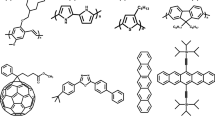Abstract
This brief article describes the content of the June 2002 issue of MRS Bulletin focusing on Electroactive Organic Materials. These materials are now being considered as the active components in displays, electronic circuits, solar cells, chemical and biological sensors, actuators, lasers, memory elements, and fuel cells. The flexibility of their molecular design and synthesis makes it possible to fine-tune the physical properties and material structure of organic solids to meet the requirements of technologically significant applications. In contrast to inorganic materials, active organic thin films can be deposited at much lower substrate temperatures (less than 120°C) in low-vacuum or atmospheric-pressure environments. It has been demonstrated that low-cost deposition techniques such as solution spin-coating, casting, and even printing can be used for the deposition of solution-soluble organic materials. These processing advantages, together with the natural abundance of organic solids, make electroactive organic materials attractive for large-area and low-cost applications.
Similar content being viewed by others
Rights and permissions
About this article
Cite this article
Bao, Z., Bulovic, V. & Holmes, A.B. Electroactive Organic Materials. MRS Bulletin 27, 441–445 (2002). https://doi.org/10.1557/mrs2002.142
Published:
Issue Date:
DOI: https://doi.org/10.1557/mrs2002.142




